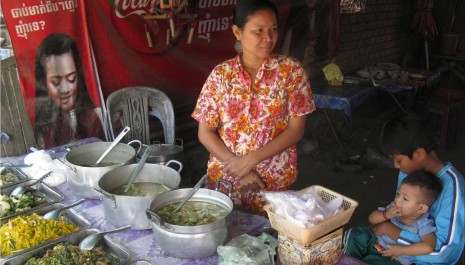Two months ago, Sok Sathya spent less than a dollar for a kilogram of oranges to sell from his sidewalk stall across from a row of garment factories in Phnom Penh’s Meanchey district.
Now the same oranges cost Mr. Sathya, 39, more than 6,000 riel, or about $1.50, per kilogram. He has, in turn, raised his prices from 5,500 riel (about $1.37) to 7,500 riel (about $1.87) per kg of oranges.
Mr. Sathya’s customers in the factories have in turn, for the most part, stopped buying his oranges.
“It’s very difficult now. In the past, everything was cheap—the goods and fruit,” he said. “I had 20 to 30 customers a day. Now I have about 10 a day.”
The price of all of the fruit that Mr. Sathya buys—longans, apples, pears, grapes and pomegranates imported from Vietnam and Thailand and sold to him by wholesalers in Phnom Penh’s Neak Meas market—has risen by about 30 percent over the past three months, he said.
“Before, I could make money and save some, but now I am struggling,” he said. This month, Mr. Sathya took out a short-term, high-interest loan from a local moneylender to keep his family of five afloat.
Mr. Sathya is not alone. Vendors throughout Phnom Penh said this week that, since the government began imposing customs tariffs on imports in November, they have seen prices soar, forcing them to either raise prices and lose customers or watch their profit margins disappear.
In an effort to increase state revenue, officials began to enforce in November customs tariffs, which have long been on the books but were rarely enforced in lieu of informal payments, on goods being imported into the country.
Though the government has yet to release official inflation rate for the months since it began implementing customs tariffs, the effect is being keenly felt on the street.
“I am losing money almost every day,” said Yin Srey Leak, 36, a mother of two who sells food out of her home on a bustling street in Sen Sok district. “There used to be 50 people coming to eat my food every day. Today, there are 10 or 20 people coming to my stall.”
In October, Ms. Srey Leak paid about 100,000 riel, or about $25, for all the ingredients for that day’s menu of about 10 different dishes. These days, it costs her more than 150,000 riel (about $37.50) per day. She has raised the price of lunch at her stall from 2,500 riel (about $0.62) to 3,500 riel (about $0.87).
“The price of everything has gone up,” she said. “But I don’t know what else to do. I will keep on selling.”
Phok Ratha, 49, who sells noodle soup in front of her home in an industrial neighborhood in Meanchey district, said that despite the rising cost of ingredients, she has resisted increasing the cost to her customers, who mostly work in nearby factories.
“Their salary is too small,” she said. “They will not buy [food] from me if I increase the price [from 2,500 riel]. I have no choice but to continue selling at the same price,” she said.
Instead, Ms. Ratha has watched her daily earnings shrink. In months past, she made up to 40,000 riel, or about $10, a day. This month, she is lucky to make more than 10,000 riel (about $2.50) in a given day, she said.
In order to keep her children fed and in school, Ms. Ratha said she is saving less and relying more on income from her husband’s corn and soybean farm in Prey Veng province.
Kang Chandararot, president of the Cambodian Institute for Development Study, said that, as a result of customs tax enforcement, inflation is being felt at all levels of society.
“Poor people are affected by the increase in tariffs because you can see there is an increase in key commodities such as oil, gas, household appliances…and even on agricultural products being imported into Cambodia,” Mr. Chandararot said.
Mr. Chandararot said he is hesitant to trust the latest Ministry of Planning figures, from November, which indicate that there was actually a decrease in the consumer price index.
“I don’t know if there is any connection to politics or not, but that CPI figure…seems not to reflect reality,” he said, estimating that there has been inflation of about 15 percent in the past two months.
Even a small shock to spending power can have a significant impact on the livelihood of Cambodia’s poorest populations, according to an October presentation from the World Bank, which said, “A shock reducing poor consumption by 1,000 riel [about $0.25] a day would double poverty.”
Hang Linna, director-general of the National Institute of Statistics, declined to comment on the government inflation data. Chea Serey, director-general of the National Bank, said she was too busy to comment.
Ian Ramage, director of Domrei Research and Consulting, said that inflation statistics are probably just lagging behind the situation on the ground.
“It was in November and December that I was hearing about trucks backing up at the border because they were being taxed about three times as much as they did before,” he said.
“The effect is just starting to be felt. People had stock and supplies and stuff on the shelf,” he said. “We will have to wait a few months to see what is really going on.”
